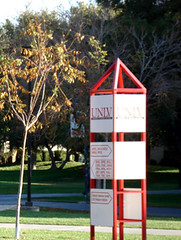 You never really know how people interpret information until they apply it elsewhere. Nowadays, some people truly believe that social media will eventually supplant websites entirely.
You never really know how people interpret information until they apply it elsewhere. Nowadays, some people truly believe that social media will eventually supplant websites entirely.Even a post by Jeremiah Owyang about integrating social functions into websites was attributed to Altimeter and reframed as another call for the death of business websites all together. (The spin itself demonstrated the venerability of social media.) However, all of the calls for the demise of websites miss the point.
Websites won't die. But their functionality will have to change.
All that really means is, somewhat to Owyang's point, social media tools and networks will be built into websites, changing the functionality from the 5-page content template into something, hopefully, that makes sense for the people who visit the site.
That has nothing to do with social media per se. It is, however, one of several reasons some people mistake why the "social media revolution" happened. It's also why news organizations continue to grapple in the new world. And it's why some social media intellects want you to believe that you and your company and your communication are powerless (unless you hire them).
Maybe a better word for the revolution is push back. For all the advances made in the early 1990s in regard to mass media communication, there was one major setback. Mass media, and its advertising and publicity bedfellows, dominated information. Even if someone was unhappy with anything, an individual voice didn't have any value compared to the conglomerate.
In fact, the only information out there was for awhile was decided on by the people with the largest audiences — agencies publishing brochures, public relations firms pitching stories, and new media setting the agenda. There was no other choice.
Social media is the revolution as much as the revolution is choice.
 In other words, if people are visiting a corporate website less, it probably has less to do with the noun "website" and more to do with the descriptor "corporate." Or, even more simply put, the reasons people don't visit or stay on a corporate website is because whatever they are looking for just isn't there.
In other words, if people are visiting a corporate website less, it probably has less to do with the noun "website" and more to do with the descriptor "corporate." Or, even more simply put, the reasons people don't visit or stay on a corporate website is because whatever they are looking for just isn't there. What is there? Generally, most corporate websites are little more than an "I love me" wall, adorned with trophies, awards, and sales pitches. Sure, some sites toss in some SEO-crooked copy, maybe some runaway advertainment, and whatever website builders can sell.
If your company website could talk, what would it say?
The whole thing is rather preposterous when you think about it. A person visits a site with an expressed interest, i.e., Who can I talk to about a product defect or service problem?
To which the site responds, i.e., Would you like to play a game?
Increasingly unhappy, the person turns to Google. Who can I talk to about a product defect or service problem?
And Google answers, i.e., I really don't know, but I can tell you where all the other people experiencing product defects or service problems are going. Would you like to go? Heck yeah!
Social networks did add another choice. Who can I talk to about a product defect or service problem?
To which the site responds, i.e., Try the live representative on Facebook or Twitter.
So, the person follows the advice to find stacks of unanswered complaints, representatives who only know what the daily deal is, or an endless stream of content that might as be labeled "see more about me on my 'I love me' wall."
Two tips for more effective online content and communication.
First, erase any notion that social media and websites are somehow different and can cannibalize each other. Saying that social media cannibalizes a website is akin to thinking that in-store salespeople somehow steal sales from an advertisement in the Sunday paper. This stuff works together. (*One caveat, duplicate social media content can cannibalize each other.)
Along with erasing the notion of separation, kill the widely adopted prospect that social media and networks are feeders to the varied 200 "about me" pages on websites. (Let's be honest, every single page of a website might as well be labeled "about me.")
 Second, start thinking about why people are coming to your website. Ninety-nine percent of the time, they are not coming to read "about me" pages, play games, or be diverted to a social network (unless the social network can answer their question).
Second, start thinking about why people are coming to your website. Ninety-nine percent of the time, they are not coming to read "about me" pages, play games, or be diverted to a social network (unless the social network can answer their question). They ask different questions. So if you want to build a more effective website, start thinking about the questions your customers and prospects ask most often. Then start thinking about what they might ask if they even knew to ask it. And then start considering the best methods to deliver the answers, which may or may not include Facebook, Twitter, etc.
Still unconvinced? Take some cues from some of the top websites in world. All of them answer very specific questions. Here are the top five most visited, recognizing that even networks are really websites with more functionality.
Where can I find some information online? Google.
What are my friends and family doing right now? Facebook.
Where can I find some video of >fill in the blankWhere can I find some information if I hate Google? Yahoo.
What if I need information and I'm Chinese? Baidu.
And so on and so forth. More to the point: If consumers are turning to social networks with increased frequency, doesn't it stand to reason that they do it because your website isn't answering their questions? Maybe that's something worth thinking about.





























